Feed aggregator
Comment on Worldbuilding Articles: Reader Poll (2025 Edition) by Randall
Truly looking forward to the third book. In the meantime, the three below are my favored topics of coverage.
1.) Branch Affinities
2.) Sigl Recycling
3.) The Board
While there are others I want to include mentioned by others in the comments, I feel those may be plot points meant to be explored as the books reveal them.
Comment on Worldbuilding Articles: Reader Poll (2025 Edition) by Dawn
Sigl fashion
Attunement
Essentia Capacity
Comment on THE CHAIN OF EYES – Tainted Cabal book 2 – news by Marcus
Dead series?
Comment on Worldbuilding Articles: Reader Poll (2025 Edition) by Justin Gasal
Sigle Recycling
Attunement
Sigle Fashion
Comment on Worldbuilding Articles: Reader Poll (2025 Edition) by Jim Sackman
I am most interested first in closing out knowledge of essentia and sigils.
After that, the structure of the drucrafting world more broadly.
So my order would be:
1 – Essentia Capacity
2 – Attunement
3 – Branch Affinities
4 – Sigl Recycling
5 – Country Affinities
6 – The Board
7 – Corporations
What a Croc, Part III
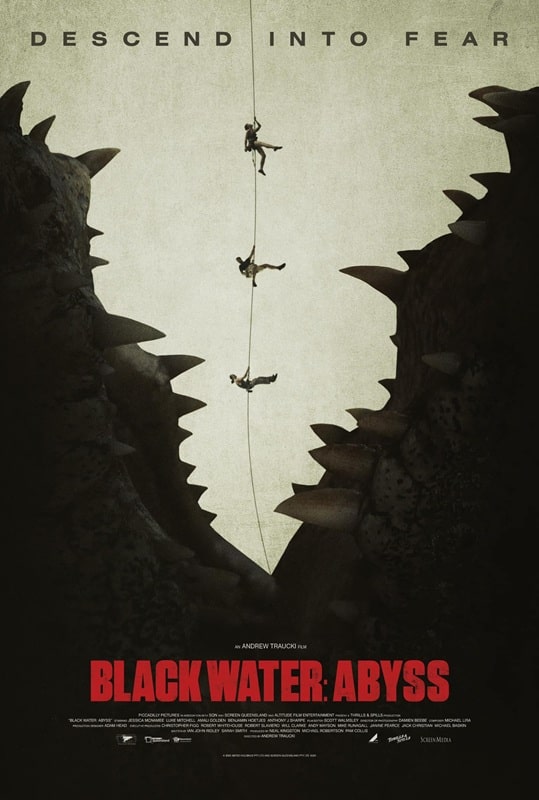 Black Water: Abyss (Altitude Film Entertainment, July 10, 2020)
Black Water: Abyss (Altitude Film Entertainment, July 10, 2020)
My next watch-a-thon is a favorite genre: crocs and gators. Unfortunately, this means the pickings are a bit slim, as I’ve already seen most of them, but I’ve managed to dig up 15 so far (supplemented with a Gila Monster and a couple of Komodos), and I’m sure the intended list of 20 will materialize as streaming services start suggesting titles.
What a Croc #14: Black Water: Abyss (2020) CrackleCroc or gator? Crocodile!
Real or faker? Some pretty great CG.
Any good? I do like me an Aussie croc flick, and this is one of them. The premise is simple: stick some folks in a cave, flood it, trap them, let loose a big croc. The spaces are tight, the tension is taut, and the croc has the good sense to eat the cast in order of character development.*
There’s a bit of relationship drama in the mix between meals, but at the end of the day it’s just a murky cocktail of Rogue and The Decent, but doesn’t come close to being as good as either. Still, I didn’t hate it, and it was well produced, so I’ll grade it a little higher.
7/10
*Now where have I seen that poster design before…?


Lake Placid: The Final Chapter (Syfy, September 29, 2012) and Rollergator (RiffTrax, 1996)
Croc or gator? Alligator(s)!
Real or faker? All terrible CG.
Any good? I still have fond memories of the first time I watched Lake Placid — I was totally unprepared for the all round brilliance of it, from the writing and the cast to the effects and direction. Sadly, each successive sequel has been horrendous, and this one, the incorrectly named ‘Final Chapter’ is the penultimate nail in the coffin.*
As you can tell from the ‘quality’ poster, the story is trite, the characters uninteresting and the effects garbage — the only redeeming features might be Robert England (hamming it up in another gator flick), and Yancy Butler (wasted here as she reprises her role as a two-pack-a-day-voiced rogue ranger). The most egregious aspect of this one though, is the directing and editing. There’s only one director who can get away with that many crash zooms, and his name is Sam Raimi.
Raimi did not direct this.
4/10
*I just discovered there are actually TWO more Lake Placid films after this one. Not that it makes this any easier.
What a Croc #16: Rollergator (1996) TubiCroc or gator? Gator. Small. Purple.
Real or faker? A hand puppet.
Any good? I tried to find the original version of this, but had to settle for the Rifftrax version. Shocking admission: I don’t find Rifftrax particularly funny (not a huge fan of MST3K either) and they just paved the way for stuff like CinemaSins and every other armchair critic who thinks they’re funny. I am fully aware of the staggering hypocrisy of this statement, but there you go.
Anyway, in this film a roller skating woman meets a small, jive talking gator and tries to get him out of the carnival and back to the swamp. Presumably written by a third-grader, it’s utter crap. Not even funny or surreal enough to be a guilty pleasure — just a miserable, miserable slog.
1/10
 Mega Shark vs. Crocosaurus (The Asylum, December 21, 2010)
What a Croc #17: Mega Shark vs. Crocosaurus (2010) YouTube
Mega Shark vs. Crocosaurus (The Asylum, December 21, 2010)
What a Croc #17: Mega Shark vs. Crocosaurus (2010) YouTube
Croc or gator? Croc. Osaurus.
Real or faker? Rubbish CG.
Any good? You know what the answer is going to be, so let’s just cut to the chase. Robert Picardo is a fine actor, he voiced the male, culturally-obsessed alien in Joe Dante’s Explorers and I love him for that. He’s also good in everything else, but I guess he needed a new deck, because he’s in this.
Gary Stretch is also in this. British boxing fans may remember the name, the rest of you will just know him as a punching bag-faced enigma with the looks of a leading man and the mystery of a Swiffer. Sarah Lieving stars opposite him as a potentially badass special investigator who is relegated to scowling boobily at the rest of the cast while flying a pretend helicopter.
The story is rote, the direction and editing are dull and the effects are tragic. The titular creatures (especially the giant croc) are rendered in spectacular blur-o-vision, unhindered by weight or physics. I feel neither joy nor despair at having watched this film, I’m just languishing in a limbo populated by cookie cutters, tight vests and pixels.
4/10


Croczilla (Beijing Enlight Pictures, 2012) and Crocodile (Lions Gate, August 26, 2000)
Croc or gator? Crocodile. Big boi.
Real or faker? Fairly decent CG (in parts).
Any good? I started watching this one quite early on in the watch-a-thon, and thought it had promise, so saved it to end on a high note. It is indeed fun, however, I would sorely love to see a subtitled version, as the English dubbing on this Chinese movie is horrendous.
Promoted as China’s ‘first monster movie’, a claim that has been made on several of the films I’ve watched from China, Croczilla is meant to be a tongue-in-cheek flick. For this reason, the actors ham it up to the level of cartoon characters, and the English V.O. artists were apparently told to do the same, because the dubbing is ear-splittingly intolerable, especially the voice of Barbie Hsu’s character, which threatened to shatter every window in the house.
Aside from the audio hell, it’s a jolly romp, with a 36 ft croc on the rampage in Hangzhou, its belly full of Yuan (about a million worth, or 100,000 Euros as the shrill dubbing informs us). The cast is likeable (although the gangsters are a trifle over the top), and the croc itself is a nice bit of CG. It’s a great model, and for the most part animated well, but some of the interactions with its environment weren’t great. Overall, I enjoyed it, and that’s what matters, so there.
7/10
What a Croc #19: Crocodile (2000) CrackleCroc or gator? Crocodile.
Real or faker? Some OK animatronics and rubbish CG.
Any good? Apparently, when I said Eaten Alive was the only Tobe Hooper film I hadn’t seen, I had forgotten about this one — and I wish it had remained forgotten. I was initially excited when I saw Hooper’s name, doubly so when I saw the effects were done by Nicotero and Berger, but it seems there was no budget for effects and Hooper couldn’t give two shits about the film.
Nobody brings anything fresh to the production, it’s the same tired old story of unlikeable frat kids getting drunk and horny in a swamp, and the only reason to watch is to see how they get dispatched. Unfortunately, save for a couple of fun shots of folks sliding down a gullet, it’s all a bit ham-fisted, and the CG croc suffers from the same weightlessness as all the other low-budget beasts of the era. A shame.
5/10
 Crocodile 2: Death Swamp (Nu Image Films, August 1, 2002)
What a Croc #20: Crocodile 2: Death Swamp (2002) Crackle
Crocodile 2: Death Swamp (Nu Image Films, August 1, 2002)
What a Croc #20: Crocodile 2: Death Swamp (2002) Crackle
Croc or gator? Crocodile. Again.
Real or faker? Some pretty great animatronics.
Any good? Hot on the heels of the disappointment of Crocodile comes Crocodile 2, which chose to ignore sequel conventions and be titled Crocodiles. Also surprisingly, it is that rare breed, the superior sequel, and I had a lot of fun with it.
No hackneyed ‘hot kids in a swamp’ plot, this one is full of bank robberies, plane crashes and helicopter hijinks. The bad guys are extremely potty-mouthed and awful enough to cheer when they get eaten, and the plucky protagonists put up a fair fight. The effects are actually pretty gruesome, and the croc itself is one of the better ones I’ve seen. Good heavens, I do believe I’ve ended on a high note!
8/10
That’s the crocs and gators done. Next up, werewolves!
Previous Murkey Movie surveys from Neil Baker include:
What a Croc, Part I
What a Croc, Part II
Prehistrionics
Jumping the Shark
Alien Overlords
Biggus Footus
I Like Big Bugs and I Cannot Lie
The Weird, Weird West
Warrior Women Watch-a-thon
Neil Baker’s last article for us was What a Croc, Part II. Neil spends his days watching dodgy movies, most of them terrible, in the hope that you might be inspired to watch them too. He is often asked why he doesn’t watch ‘proper’ films, and he honestly doesn’t have a good answer. He is an author, illustrator, outdoor educator and owner of April Moon Books (AprilMoonBooks.com).
Comment on Worldbuilding Articles: Reader Poll (2025 Edition) by Saul Silver
1.Sigl Fashion
2.Sigl Recycling
3.Country Affinities
4.The Board
5.Corporations
6.Branch Affinities
7.Essentia Capacity
8.Attunement
Comment on Worldbuilding Articles: Reader Poll (2025 Edition) by Philipp
The Board
Love of Family & Land in “A Fort of Nine Towers” by Qais Akbar Omar
A Fort of Nine Towers is one of the rare memoirs of Afghanistan to have…
The post Love of Family & Land in “A Fort of Nine Towers” by Qais Akbar Omar appeared first on LitStack.
THE FROZEN PEOPLE by Elly Griffiths
Book Review: Emily Wilde’s Compendium of Lost Tales by Heather Fawcett
I received a review copy from the publisher. This does not affect the contents of my review and all opinions are my own.
 Emily Wilde’s Compendium of Lost Tales by Heather Fawcett
Emily Wilde’s Compendium of Lost Tales by Heather Fawcett
Mogsy’s Rating: 4 of 5 stars
Genre: Fantasy
Series: Book 3 of Emily Wilde
Publisher: Del Rey (February 11, 2025)
Length: 368 pages
Author Information: Website
Having followed Emily and Wendell’s journey through the first two books of this series, I was excited to see how the trilogy will end, especially now with the weight of a faerie realm hanging in the balance. I’m happy to say Emily Wilde’s Compendium of Lost Tales delivers a satisfying and enchanting conclusion that offers the perfect balance between adventure, scholarly curiosity, and whimsical charms—all the things that made me fall in love with this series in the first place.
Before we proceed, a mild spoiler warning for the previous books if you haven’t caught up yet. The story finds Emily Wilde and her fiancé, Wendell Bambleby, coming to terms with their new roles as rulers of Wendell’s ancestral kingdom in Faerie. As someone who has dedicated her life to dryadology, or the study of faeries, Emily has always preferred learning about her beloved subject from the safety of university classrooms and libraries. This new development, however, will thrust her out of her comfort zone and into the dangerous politics and intrigues of the fae world. And things are not exactly stable right now in Wendell’s realm!
Before vanishing, Wendell’s spiteful and ruthless stepmother Queen Arna had placed a curse on the land, leaving it clinging onto life. To lift the curse and return the realm to normal, Emily leaps into her role as the new queen not only to support Wendell, but also to stay true to her academic roots, resolving to find an answer in her rich knowledge of faerie stories. In this world, she may feel like a fish out of water, but when it comes to fae lore, there is no greater expert. If there’s even a grain of truth in these legends, or a clue that may help, our protagonist is determined to find it.
For a sequel that picks up right after the previous book left off, Emily Wilde’s Compendium of Lost Tales gets off to a relatively slow start. For the first half of the book, it feels as if barely anything happens. Sure, Wendell has to face up to his new responsibilities as king, going through the motions of posturing and winning a few duels here and there. But for the most part, we don’t move past much past the central conflict that his realm is under threat. Emily also plays her role as an outsider, perhaps a bit too well. This section sees her without much agency, being tossed around the court, doing wherever her new duties as acting queen requires of her. She’s meek, she’s unsure, and she spends a lot of this time either going with the flow or simply staying out of the way.
That said, there is a silver lining. We’ve spent most of the last two books in Emily’s sphere of influence, but we’re in Wendell’s now. And what we learn is that sweet, easygoing Wendell can in fact be very scary if the need calls for it. The interactions become so much more interesting in this new dynamic, for while the relationship and banter between our two main characters remain light and airy, we can tell Emily is still getting used to seeing Wendell in his new role. Of course, she is still important to him, and the romance between them is alive and well. But with his kingdom and his people in peril, there are other things to occupy his attention. It’s a significant adjustment— not just for our protagonist, but for me as a reader as well.
Perhaps not coincidentally, the story picks up at around the same time Emily regains some of her confidence reflected in the passion for her work. That’s when both the novel’s pacing and the world’s imagination come alive again. Emily’s no-nonsense intellect takes over, making some headway into finding a solution, all the while giving readers a chance to indulge in delightful fae lore. As she delves deeper, the book’s vibe shifts to weaving in intrigue and danger, with the tensions building to a satisfying conclusion.
In the end, Heather Fawcett gives us fans the gift of a strong final installment in Emily Wilde’s Compendium of Lost Tales. This ending might have been heartfelt and bittersweet in its poignancy yet still felt just right—a fitting farewell to our unforgettable couple, Emily and Wendell.
![]()
![]()
More on The BiblioSanctum:
Review of Emily Wilde’s Encyclopaedia of Faeries (Book 1)
Review of Emily Wilde’s Map of the Otherlands (Book 2)
Comment on Worldbuilding Articles: Reader Poll (2025 Edition) by Dennis Brown
Sigl Recycling
Comment on Worldbuilding Articles: Reader Poll (2025 Edition) by Brian Bray
1. The board
2. Corporations
3. Sigl recycling
4. Country affinities
5. Sigl fashion
The Fiction of Edgar Rice Burroughs, Part III: The Westerns and The Mucker
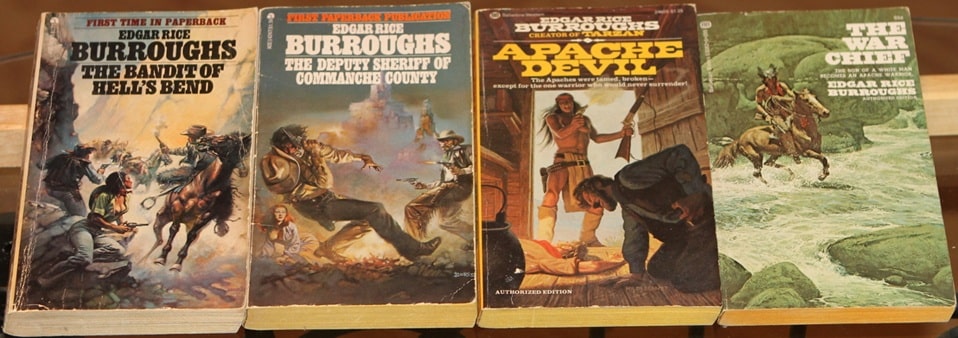 Westerns by Edgar Rice Burroughs: The Bandit of Hell’s Bend and The Deputy Sheriff of Commanche County (Ace Books); Apache Devil and The War Chief (Ballantine Books). Covers by Boris Vallejo, the Brothers Hildebrandt, and Frank McCarthy.
Westerns by Edgar Rice Burroughs: The Bandit of Hell’s Bend and The Deputy Sheriff of Commanche County (Ace Books); Apache Devil and The War Chief (Ballantine Books). Covers by Boris Vallejo, the Brothers Hildebrandt, and Frank McCarthy.
Like many pulp writers of his day, ERB dipped his toes into the western genre. He wrote four: two pretty standard ones and two that incorporate the Native American experience. He knew something of what he wrote, having worked on his brother’s ranch in Idaho at age 16, and having served with the 7th cavalry in Arizona in the late 1890s.
His first standard western was The Bandit of Hell’s Bend (1924), followed by The Deputy Sheriff of Commanche County in 1940. Both of my copies are later printings from Ace with very cool Boris illustrations. I like these better than many of Boris’s paintings because they seem less static. He does a good job of portraying action here.
In Bandit, we have a disgraced ranch foreman and a young woman who has inherited the ranch, and various villains who want to steal the ranch from her because they know there’s silver on it. The foreman, Bull, has to rise to the occasion. There’s great action and pretty good plotting, although you’ll probably figure it out pretty soon. And, as always, ERB creates sympathetic heroes and dastardly villains.
In Deputy Sheriff, a cowboy named Buck Mason is suspected of a murder he didn’t commit, and he has to run and hide until he has a chance to prove his innocence. This plot is not as good as Bandit but it gets the job done to showcase ERB’s lightning paced tale.
ERB’s other two westerns are connected and center very strongly on the Native American experience. The hero, though, is a white boy who is taken captive by Apaches and raised as Geronimo’s adopted son. He is given the Apache name of Shoz-Dijiji (Black Bear), for having killed one at a young age, and he grows up hating whites.
These books are The War Chief (1927), and Apache Devil (1933). Although there are some stereotypical elements to these books, they show that ERB had very strong sympathies for the Apache and disapproved of the way they had been treated by whites.
I found all of these books well worth reading, though the Apache books have stayed with me the longest. The cover art for The War Chief is magnificent and is by Frank McCarthy. The Apache Devil cover looks to be signed by Hildebrandt.
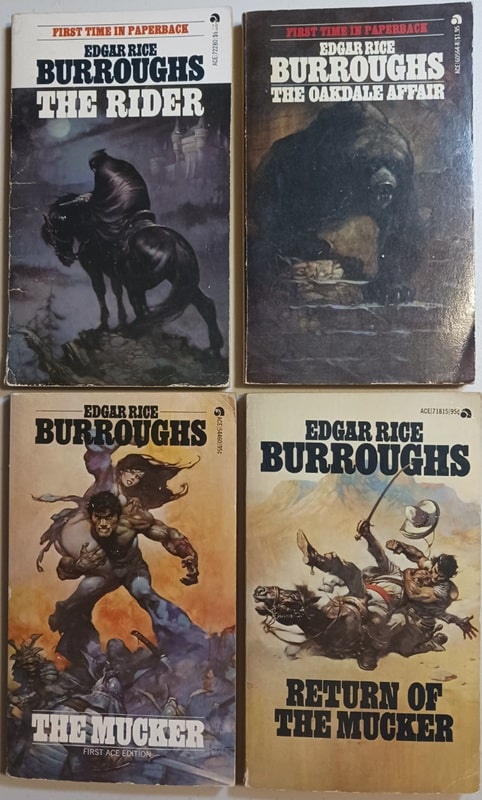 The Rider, The Oakdale Affair, The Mucker, and Return of the Mucker (Ace Books). Covers by Frank Frazetta.
The Rider, The Oakdale Affair, The Mucker, and Return of the Mucker (Ace Books). Covers by Frank Frazetta.
ERB wrote a three book series generally called The Mucker. They were first published in magazines in the mid to late 1910s, but I have much later reprints, of course, from the 1970s. All of mine, shown here, are from Ace books with Frazetta covers. I particularly like the first book cover, although all are cool.
The Mucker (1914). Billy Byrne is born on the mean streets of Chicago and grows up a criminal. After being accused of murder, he flees to San Francisco and ends up shanghaied. A shipwreck leaves him and a beautiful high society girl stranded in an east Asian jungle and she needs rescuing. I really liked the development of the character here. Through love, Billy learns how to be a decent human being and becomes quite a hero.
The Return of the Mucker (1916). This book finds Billy trying to clear himself of his previous murder charges and failing. He ends up in Mexico in the midst of a revolution. And it so happens that his love interest from the first book, Barbara, is also there. The Mucker was a very fine novel but the sequel is pretty weak. Coincidences pile upon coincidences until it’s pretty hard to suspend belief. But it still has the action rolling. This one could easily be counted as one of his westerns given the setting.
The Oakdale Affair (1918). I’m not sure what ERB was striving for with this book. It’s got mystery elements, gothic elements, horror elements, western type elements. He put everything and the kitchen sink into this one. But it worked and I enjoyed it. It is only peripherally related to the Mucker stories in that it features a hobo character that appeared in The Return of the Mucker.
I included ERB’s The Rider here because of the Frazetta cover and because it was at one point published in a double with The Oakdale Affair. But it’s not part of the Mucker series. It involves a bandit called “The Rider” who exchanges places with a prince (Boris) who is about to be married to the princess of another European duchy (neither of whom want to marry the other). Chaos ensues. ERB crammed a lot of action and plot twists into this short work.
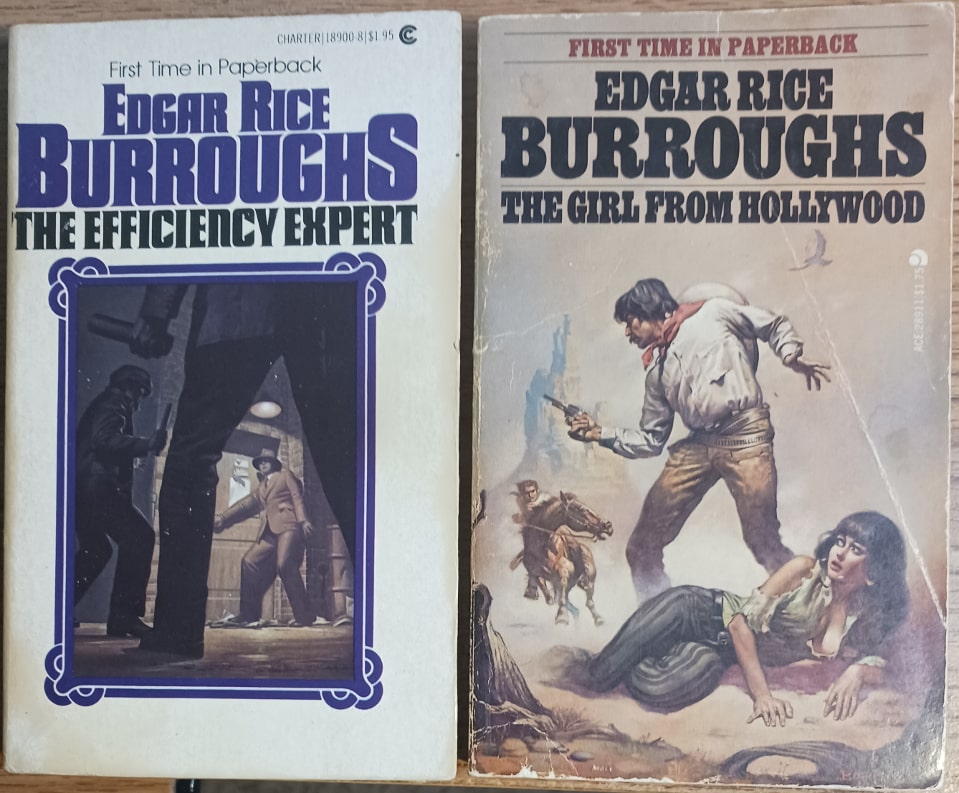 The Efficiency Expert (Charter, 1979) and The Girl From Hollywood (Ace Books, 1977). Covers by John Rush and Boris Vallejo
The Efficiency Expert (Charter, 1979) and The Girl From Hollywood (Ace Books, 1977). Covers by John Rush and Boris Vallejo
My favorite genres are Fantasy, SF, Westerns, Horror, and Thrillers. I don’t read a lot of straight mysteries and read relatively little “mundane” fiction. By mundane, I mean fiction set in a modern world where the happenings are portrayed as realistic. After reading ERB’s westerns and everything he wrote with fantastic elements, I was left with three books: The Girl from Hollywood, The Efficiency Expert, and The Girl From Farris’s.
They were also among the more difficult ERB books to find and were expensive, but I wanted them because they were… well, ERB. I got both Girl and Efficiency in 1970’s paperback form but couldn’t get Farris and finally ordered it in a modern paperback printed from public domain materials. Here are my capsule reviews.
The Girl from Hollywood (ACE, 1977, Boris Cover) is not quite a western. It takes place in the 1920s, but much is set in a western landscape and involves many western tropes. The plot involves a fine western family whose lives become entangled with Hollywood types. Some of these are basically good and recover from their evil natures while others never do.
As is typical of ERB’s work, there are coincidences that help the plot along, and there’s actually very little action compared to his typical story. However, the sheer narrative drive that ERB was able to bring to his tales keeps you reading. I finished it in one day, if not quite one sitting. Not my favorite work by him by far, but still enjoyable.
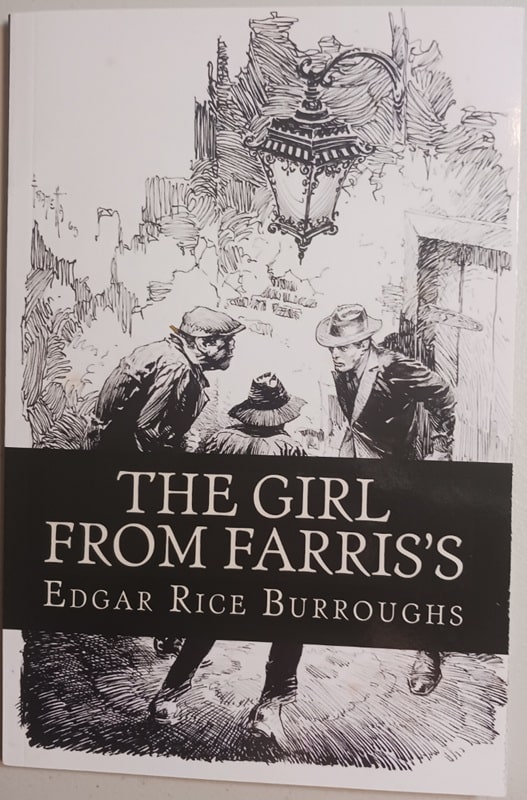 The Girl from Farris’s (CreateSpace edition, 2017). Cover by Frank Frazetta
The Girl from Farris’s (CreateSpace edition, 2017). Cover by Frank Frazetta
The Girl from Farris’s (Public Domain, from CreateSpace, 2017). The cover is by Frank Frazetta. An editorial note names Taylor Anderson as editor, and claims the publisher is Odin’s Library Classics. The text appears to be intact but the print is small and there are no indented paragraphs. I actually read this in ebook version, though, so I’ll just stick it on my shelves. I rather like the cover but don’t know where it came from.
“Farris’s” is a house of ill repute and June Lathrop a lady of the evening who is trying to escape it. She meets a young man — Ogden Secor — who wants to help her and fate keeps throwing them together. It’s a tale of redemption, which is an element in all three of these novels. One particularly interesting point is that Ogden is a failed Chicago businessman who tries to make a new life for himself in Idaho. ERB himself fled the business world of Chicago for his brother’s Idaho ranch. They say, “write what you know.”
The Efficiency Expert (Charter, 1979, cover by John Rush) is the last Burroughs book I’ve read, and very nearly the last one to exist that I hadn’t read. I left these three to last thinking they weren’t much up my alley. None of them have any fantastic elements. Efficiency Expert is a straightforward and realistically based story of a young man of quality who is down on his luck but never succumbs to corruption and wins out in the end. I was engrossed throughout. There’s certainly plenty of coincidence featured in the plot but I didn’t mind it much and even without a lot of action happening, it had narrative drive and kept my attention.
I’d rate Efficiency the best of the three, followed by Hollywood and Farris’s.
We’ll wrap up Burroughs next time with a look at his Hollow Earth tales.
Previous installments in this series include:
The Fiction of Edgar Rice Burroughs, Part I: Sword and Planet
The Fiction of Edgar Rice Burroughs, Part II: Tarzan and The Land That Time Forgot
Charles Gramlich administers The Swords & Planet League group on Facebook, where this post first appeared. His last article for Black Gate was The Fiction of Edgar Rice Burroughs, Part II: Tarzan and The Land That Time Forgot.
Comment on Worldbuilding Articles: Reader Poll (2025 Edition) by Matt
1. Essentia Capacity
2. Sigl fashion
Comment on Worldbuilding Articles: Reader Poll (2025 Edition) by Bill
1) Sigl Recycling & Essentia Storage (Aurum)
2) [Write-In] Spiritual Entities/factions & their special ‘Gifts’
3) [Write-In] Cults (like The Winged) who align to Spirits
4) [Write-In] Creating Sigl for other species (As above)
Comment on Worldbuilding Articles: Reader Poll (2025 Edition) by Kevin
1. Country Affinities.
2. Branch Affinities.
3. Corporations.
4. The Board.
5. Essentia Capacity.
Not sure if these would count as spoilers but if not then.
1. Spiritual Entities that grant’s Steven’s Essentia Sight and other “gifts.”
2. The big Cults from the Winged, the Order of the Dragon and the other big Cult.
3. The minor Cults such as Ogun and Perun that the gang and strike teams follows as well as other similar groups.
Chapter 2 Part 2

The lavender was dying. Elara surveyed the wilted stalks, with drooping leaves and sagging buds. There were five main causes of lavender wilt: overwatering, underwatering, poor drainage, not enough light, and too much heat. None of it applied. They had grown lavender in this greenhouse for years.
Next to her Jean Bradshaw twisted her hands. A plump, middle-aged woman, with golden skin and a gathering of freckles on her nose, Jean was the aromatics master. Basil, mint, rosemary, all of it was her domain.
Behind Jean three of her gardeners waited, their expressions pinched.
“It isn’t anything you did,” Elara told her.
“I’ve tried everything. Nothing works.” Jean rubbed her face and pressed her hands, palms together, to her lips, as if praying.
They both knew what this meant. They were going to lose this lavender harvest.
Lavender was a staple. It wasn’t exciting, rare, or expensive, but they used it constantly in all sorts of ways. It was a go-to aromatic for cosmetics and bath products. It soothed headaches, calmed nerves, prevented the formation of scars, and it was slightly antiseptic. It was employed in child blessing rituals and for sun invocations. Magic users who meditated bought it by the sack. A big chunk of their income depended on lavender. There was a reason why they grew it year around.
Elara resisted the urge to rock back and forth. Why was this happening? Why?
“And the thing is, the lavender in the Red Greenhouse is perfectly fine,” Jean said. “Same soil, same watering schedule, same light conditions… The two greenhouses are next to each other. You’d think if one went bad, the other would too, but no, it’s this one and the Blue and the Yellow. And the Yellow is almost fifty yards away.”
An idea tugged on Elara. She turned and strode out of the greenhouse into the gardens. The fall air mugged her, dry and cool after the humid warmth of the greenhouse.
The Red Greenhouse with its perfectly healthy lavender was to the left and behind her, about twenty yards down the path. The Blue Greenhouse, full of dying mint, stood about twenty yards in front of her and to the right. Then the Yellow Greenhouse, where oregano had turned to near dust, was all the way to the left and forward…
Ismael came running down the path, flying as fast as his ten-year-old legs could carry him. He crashed to a stop in front of her and struggled to catch a breath.
“Take your time,” she told him.
“People from Aberdine are here,” he announced.
What now? “Did anyone send a word to the Preceptor?”
Ismael nodded frantically.
Ever since Hugh took his Iron Dogs and saved Aberdine, they treated him with a respect bordering on reverence. She had been supplying them with beer, medicine, and cosmetics for years, and none of that mattered compared with Hugh riding in to save the day in his black armor. She provided them with necessities, and he had given them a hero. A big strong man in black armor on a giant pale horse.
In some regards, it was a proof of her success. She’d done her best to appear as a good, reliable, non-threatening neighbor. They had no idea how scary she could truly be. They would never see her as a possible savior. But Hugh? Oh yes. When that man wanted to, he could be damn impressive.
Individuals were complicated, but people were simple. Hugh understood that. He knew by some uncanny instinct what people needed him to be and then he became that to get what he wanted. Even now, she had no idea if the Hugh she saw every day was truly who he was or if he’d just assumed the role for some secret gain.
One thing for sure – Hugh could turn on a dime, and when that mask came off, he unleashed shocking brutality and he did it without hesitation or doubt. If Aberdine was very unlucky, it would learn that today.
“Where are they now?” she asked.
“Johan put them into the visitor room. They are beat up.”
“The Aberdine people?”
Ismael nodded.
Beat up Aberdine people was the last thing she needed right this second.
“Johan gave them drinks and sandwiches.”
“Go back and tell Johan to keep them occupied. Then go to the wall by the front gate and wait until Hugh comes back. Come and get me as soon as you see him ride out of the woods.”
Ismael nodded again, turned around, and took off like a deer back up the road toward Baile.
“Maybe it’s him,” Jean said.
“Who?”
Jean hesitated. “The Preceptor.”
“What about him?”
Jean paused.
“Say what’s on your mind,” Elara prompted.
“The herbs started dying after the Iron Dogs showed up.”
The three gardeners went very still. Clearly, this theory had been discussed. By now it had probably spread all through the gardener crew.
She had to nip this in the bud, or it would fester.
“When do you think the first wilt happened?” she asked mildly.
“Jimsonweed field,” Jean said. “A month after they came.”
Elara shook her head. “You’re thinking in terms of fields and greenhouses. Think before that, to something much smaller. What was the first batch of plants that died just like the lavender?”
Jean pondered it, frowned, looked at the sky, and turned to her. “The kitchen garden!”
Elara nodded. The cooks maintained a small herb garden for the Baile’s kitchens, a few rows of onion, garlic, dill, and parsley. One day it had simply withered.
“When did it die?” she asked.
“The end of July,” Jean said. “We thought the fertilizer had been contaminated with something.”
“And the second wilt? Who can tell me?”
Caro, one of the gardeners, raised his hand. “The raspberry bushes. They died on the fifth of August. I remember this because it was Savannah’s birthday.”
The patch of raspberry bushes had sprung up by the castle walls completely on its own. They didn’t know if someone planted it or if some raspberries had been discarded there. In any case, the bushes grew wild until one day they wilted to nothing.
“Hugh d’Ambray didn’t even know we existed until September,” Elara said.
Jean opened her mouth and closed it.
“The Iron Dogs fought and died for us,” Elara said. “This is their home. The Preceptor has no power over plants, and even if he did, why would he interfere with our herbs? The Iron Dogs depend on us for their shelter, food, and equipment. They’ve been salvaging metal from the forest to help us offset the costs. What would they gain from causing us to lose money?”
Silence answered.
“I need the four of you to go back to the people you gossiped with and let them know what I said,” she told them. “There is no more us and them. We stand as one. Do you understand?”
Heads bowed.
“Yes, my lady,” Jean told her.
“Thank you. Now let’s see the other greenhouses.”
The post Chapter 2 Part 2 first appeared on ILONA ANDREWS.
Love, Deals, and a New Cover in the Air
Happy February! It’s the season of love so I thought it was the perfect time to share the cover for my next book, THE HOUSE SAPHIR. If you follow me on Instagram, you’ve heard me talk about working on this Bluebeard retelling for some time now, but now that it has a cover, it feels really real! It comes out in November and I’m so excited to share it with you.
Mallory Fontaine is a fraud. Though she comes from a long line of witches, the only magic she possesses is the ability to see ghosts, which is rarely as useful as one would think. She and her sister have maintained the family business, eking out a paltry living by selling bogus spells to gullible buyers and conducting tours of the infamous mansion where the first of the Saphir murders took place.
Mallory is a self-proclaimed expert on Count Bastien Saphir – otherwise known as Monsieur Le Bleu – who brutally killed three of his wives more than a century ago. But she never expected to meet Bastien’s great-grandson and heir to the Saphir estate. Armand is handsome, wealthy, and convinced that the Fontaine Sisters are as talented as they claim. The perfect mark. When he offers Mallory a large sum of money to rid his ancestral home of Le Bleu’s ghost, she can’t resist. A paid vacation at Armand’s country manor? It’s practically a dream come true, never mind the ghosts of murdered wives and the monsters that are as common as household pests.
But when murder again comes to the House Saphir, Mallory finds herself at the center of the investigation―and she is almost certain the killer is mortal. If she has any hope of cashing in on the payment she was promised, she’ll have to solve the murder and banish the ghost, all while upholding the illusion of witchcraft.
But that all sounds relatively easy compared to her biggest challenge: learning to trust her heart. Especially when the person her heart wants the most might be a murderer himself.
And voila, the cover:
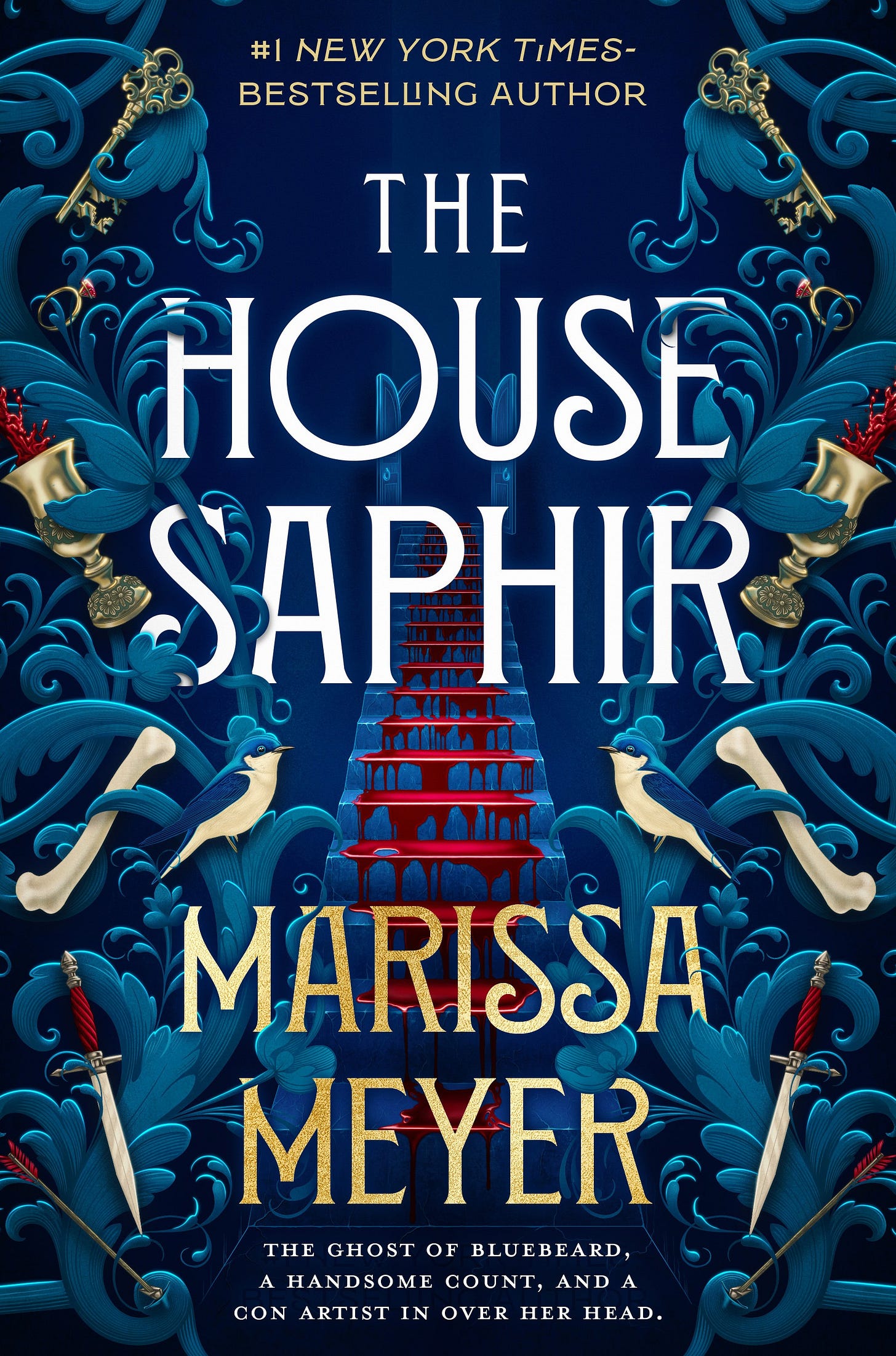
Don’t you love it?
Artist: Andrew Davis @andrewdavis_designs
Cover design: Rich Deas @richdeas
THE HOUSE SAPHIR comes out November 4, but you can preorder your copy now at my store at Bookshop.org or wherever you get your books. Don’t forget to keep those receipts *hint, hint*.
While you’re book shopping, if you haven’t picked up the HEARTLESS ebook, now’s a great time – it’s on sale all month. In other great news, Bookshop.org (that supports indie bookstores) now has ebooks so you can grab your copy there.
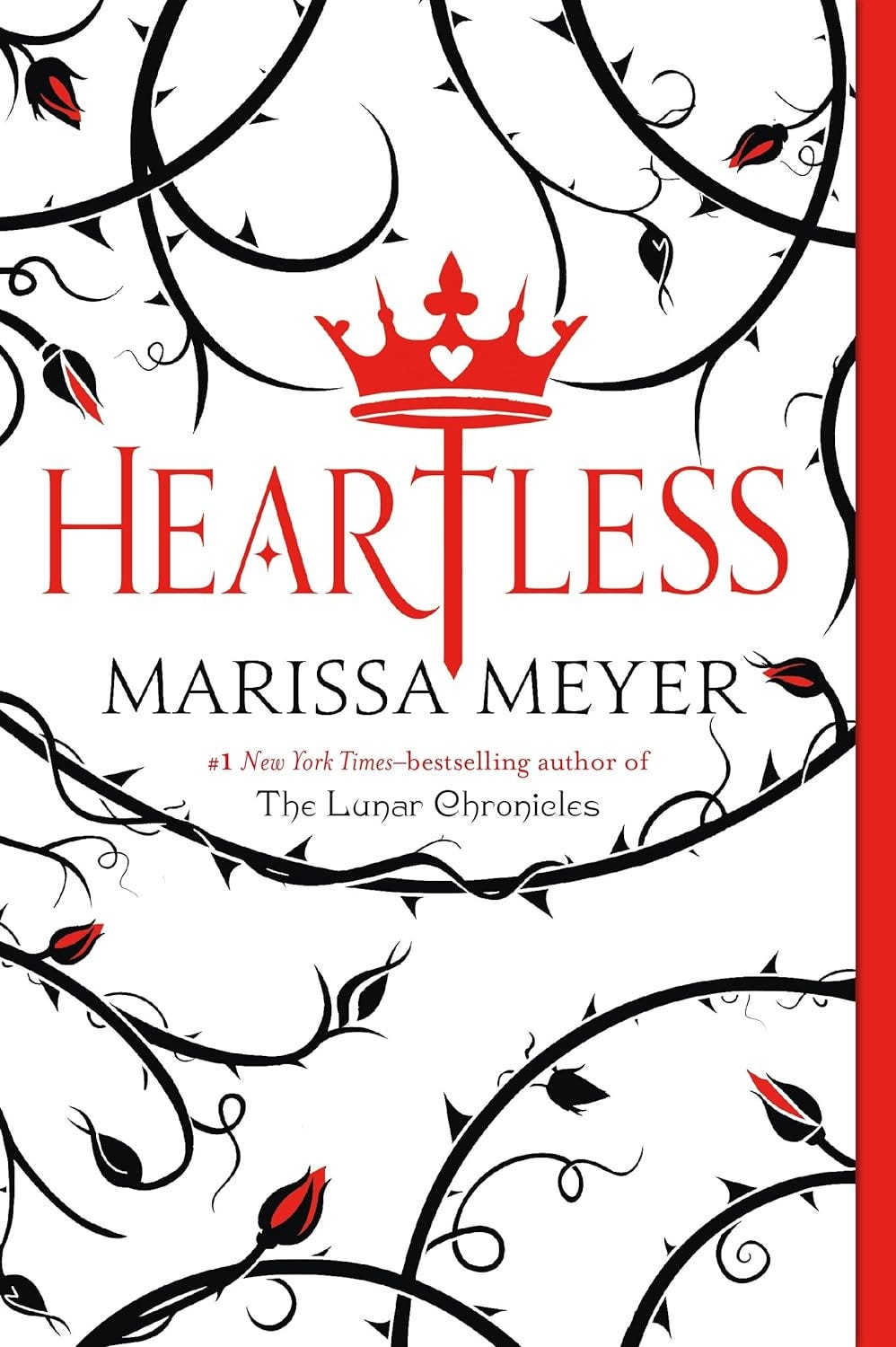
Speaking of sales, everything at my Etsy shop is 25% off for all of February. From stickers, to wearables, find your official Marissa Meyer and The Happy Writer merch here.

It’s been a couple of weeks since THE HAPPY WRITER, Get More Ideas, Write More Words, and Find More Joy from First Draft to Publication and Beyond came out and I couldn’t be more grateful for the amazing feedback my first non-fiction book has already received. This book is so personal for me and encompasses everything I try to practice in my own writing life, so finding that it’s resonating with readers is so validating.
Thank you for reading and sharing your feelings on social media and in reviews!

Here are a couple of review snippets from Goodreads:
An incredible exploration of the writing world unfolds here, covering everything from imposter syndrome to query letters and much more. Marissa transitions seamlessly between topics, keeping the flow engaging. I was captivated from beginning to end, and her narration in the audiobook added an even more uplifting vibe to the experience. Being a happy writer encompasses so much more than just the craft; it truly is a calling. ~ Amanda
“The Happy Writer” by Marissa Meyer is a helpful guide for seasoned writers and beginners alike. This guide has a wide array of practical advice from where to find inspiration to showing kindness to yourself throughout the writing process. Marissa’s tone encapsulates the joys of writing. Her stance is uplifting, showing all writers that they can work through challenges to find their flow. Marissa is like a warm, encouraging friend who believes in you, giving you the pep talks you need so you won’t give up on your draft. The conversational tone makes this guide a breeze to read and the tips are easy to apply. ~ Danielle
If you haven’t picked up your copy yet:
Buy Links: Bookshop | Barnes and Noble | Indigo (Canada) |
Don’t forget, the audio is available, too, read by me!
More buy links and audio/ebook excerpts here.
Until next time, stay inspired and keep writing.
With love,
Marissa
The post Love, Deals, and a New Cover in the Air first appeared on Marissa Meyer.
Taken by an Immortal Elf - Book Review by Voodoo Bride
 Taken by an Immortal Elf(Elves Among Us: Forbidden Love #0.5)by L.E. Sunwick
Taken by an Immortal Elf(Elves Among Us: Forbidden Love #0.5)by L.E. SunwickWhat is it about:My captor sees me as one of those destroying his sacred forest. I see him as the most gorgeous male on earth.So handsome. Those muscles. That athletic self-confidence. He is an immortal elf more than a century older than I. He calls me a lioness because I stand up to my wealthy uncaring parents - and him. Ours is a forbidden attraction. He is an elf of legend. I am a mortal duchess and a human he does not trust. We cannot be together.But I would sacrifice my happiness to save his sacred lands from my parents’ greed. My brief time with him was a lifetime’s worth. If I don’t do something, lives - and our budding love - may be lost. Even the courage and prowess of a hundred real lionesses may not be enough. But for a tiny chance at true love, I am willing to find out.
What did Voodoo Bride think of it:I recently participated in one of those 'Stuff your Kindle' events, and got signed up for tons of newsletters because of it. One of them was the newsletter of L.E. Sunwick. When there was a call for ARC/early readers for a rewritten book 1 in this series I got curious, signed up, and dug through my Kindle app what story of L.E. Sunwick I downloaded. It turned out to be this prequel story, so I decided to immediately give it a try.
And this turned out to be such an enjoyable read, that has several things I can't resist in my romances.
Hunky immortal elf: check!Heroine I liked from the start: check!Forbidden Love: double check!
This is a short story (82 pages), but it feels complete, and has romance, action, steam, and sacrifice. I finished this in no time at all, and you can be sure I'm already looking forward to reading more in this series. Each book can be read as a standalone as well I've been told, so I might check out book 2 soon.
Why should you read it:It's a very enjoyable Fantasy Romance read

Recent comments